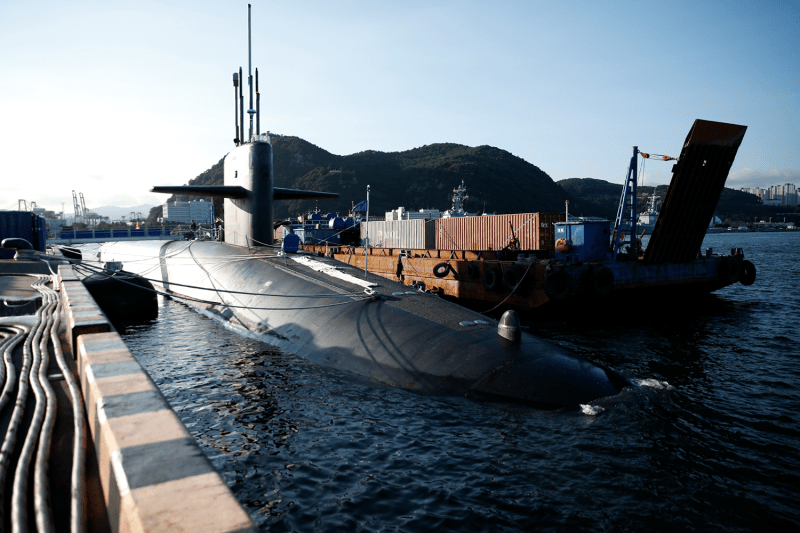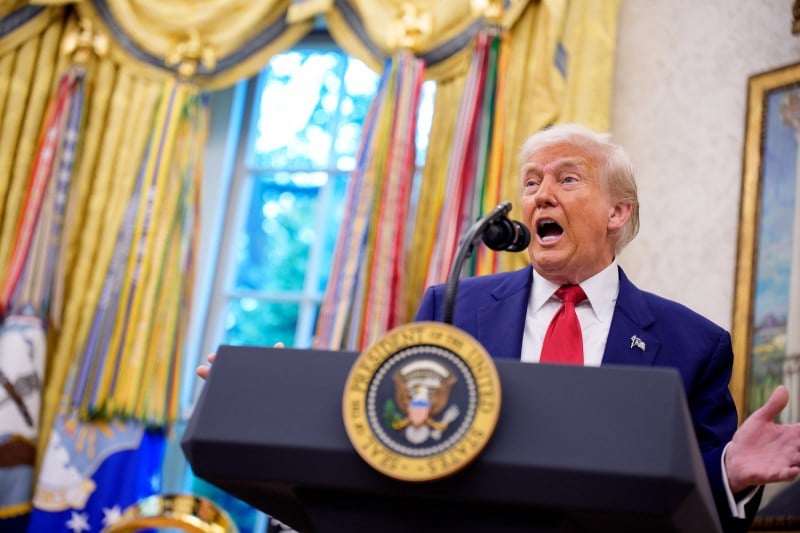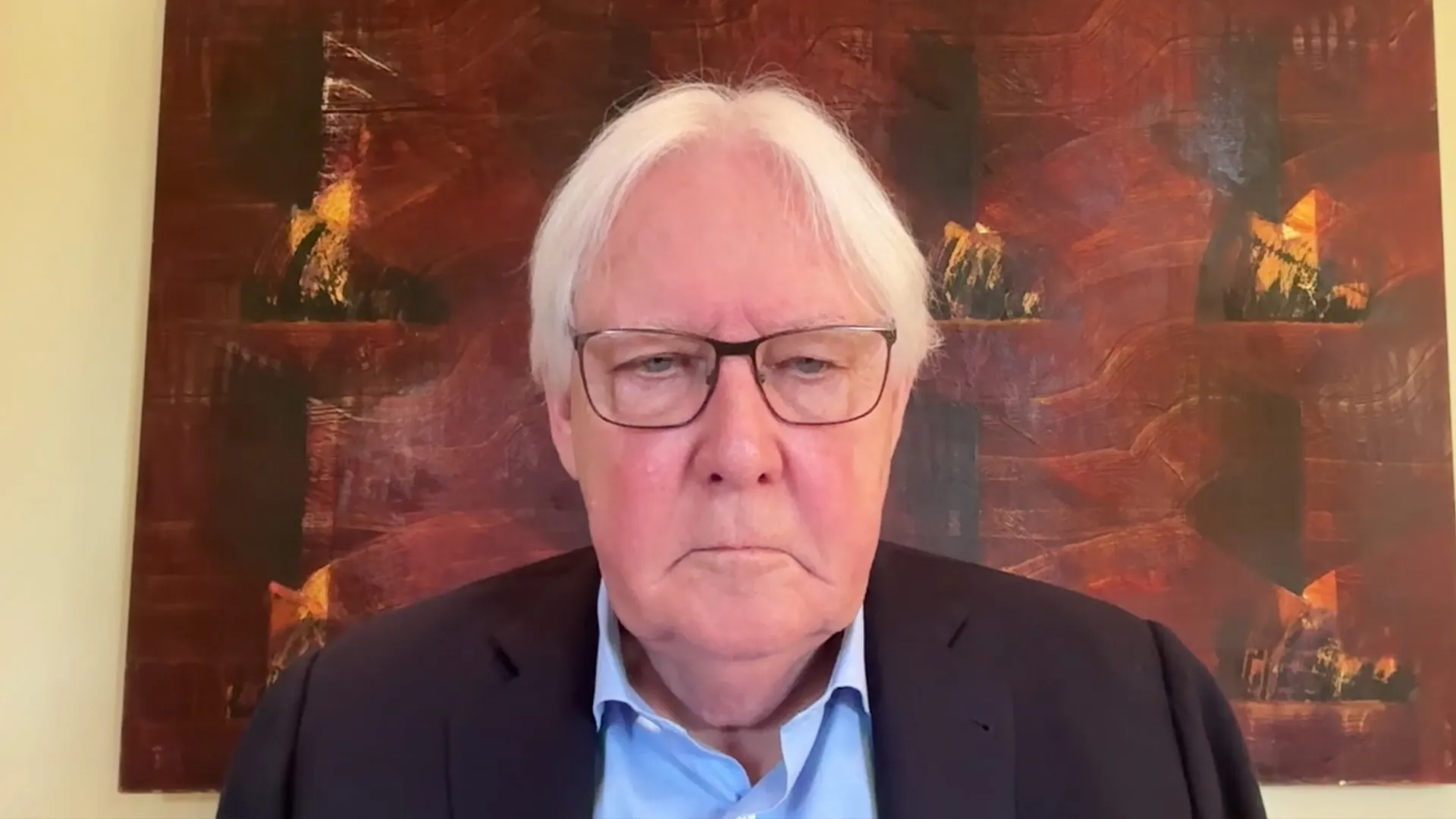The U.S. Military Needs to Relearn Nuclear Signaling

The U.S. Military Needs to Relearn Nuclear Signaling
A more flexible force can be a stronger deterrent in a crisis.
The USS Kentucky anchored in Busan, South Korea, on July 19, 2023. Woohae Cho/Getty Images
For decades, the United States’ extended nuclear deterrent has backstopped nuclear stability and supported nuclear nonproliferation among U.S. allies. Nuclear-sharing agreements and security guarantees have solidified nuclear deterrence, and combined conventional exercises have helped allies and partners feel secure in the face of hostile adversaries.
However, as the Trump administration openly reexamines the extent and depth of its alliance commitments, the credibility of the U.S. extended deterrent is fading. In response, the acquisition of sovereign nuclear capabilities has emerged as a legitimate policy pursuit in Japan, Korea, and Ukraine. These trends portend nuclear proliferation, threatening the nuclear balance and increasing the likelihood of nuclear use.
For decades, the United States’ extended nuclear deterrent has backstopped nuclear stability and supported nuclear nonproliferation among U.S. allies. Nuclear-sharing agreements and security guarantees have solidified nuclear deterrence, and combined conventional exercises have helped allies and partners feel secure in the face of hostile adversaries.
However, as the Trump administration openly reexamines the extent and depth of its alliance commitments, the credibility of the U.S. extended deterrent is fading. In response, the acquisition of sovereign nuclear capabilities has emerged as a legitimate policy pursuit in Japan, Korea, and Ukraine. These trends portend nuclear proliferation, threatening the nuclear balance and increasing the likelihood of nuclear use.
To address these assurance challenges and bolster deterrence, the Trump administration should restore a long-deteriorated aptitude: U.S. nuclear operations and signaling. Nuclear signaling is the visible, credible communication of a nation’s nuclear capability and resolve. Reinvigorating this skill means restoring the United States’ ability to quickly exercise or deploy tailored, visible, and flexible nuclear forces in a crisis.
Much has been written on expanding and reshaping the United States’ nuclear arsenal to contend with a two-near-peer (2NP) nuclear environment and manage the associated assurance challenges. But developing new nuclear weapons will take years, cost billions, and may only contribute marginal deterrent value.
In contrast, restoring an emphasis on nuclear exercises and missions—the way the United States plans, trains, and prepares to use its nuclear forces—simultaneously strengthens today’s force, assures allies, and better prepares the United States for a wide range of future crises.
In the 1990s and 2000s, nuclear missions were demoted to the periphery of U.S. defense priorities. In the unipolar post-Cold War moment, a genuine hope that nuclear weapons could be eradicated prevailed, and nuclear missions and exercises gave way to low-intensity conventional operations and a focus on arms control. As the Joint Staff deprioritized nuclear missions, nuclear-capable platforms were increasingly used for conventional operations, such as NATO airstrikes in Kosovo.
In the 2000s, the Bush administration pushed further denuclearization. Over the course of the global war on terror, nuclear budgets were cut, modernization programs stalled, and life extensions held the strategic nuclear triad—bombers, intercontinental ballistic missiles (ICBMs), and ballistic missile submarines (SSBNs)—together.
The absence of future-focused nuclear thinking persisted well into the 2010s; the Joint Staff did not publish any new doctrine on nuclear operations between 2006 and 2019. A strategic emphasis on nuclear deterrence returned in 2018 with the first Trump administration’s Nuclear Posture Review, and it continued under the Biden administration. Despite this new emphasis, a reprioritization of nuclear missions at the operational level has still yet to take hold. As a result, operational-level competencies—the planning, training, and exercising essential to nuclear missions—have been rusting in plain sight for decades.
The results have been dire and dangerous. In 2007, Minot Air Force Base personnel erroneously and without authorization loaded nuclear weapons onto a B-52. In 2013, episodes of public drunkenness and failed safety inspections among Minot’s ICBM force made fresh headlines. A missileer exam cheating scandal further rocked the force that same year. In 2023, a failed Minuteman III ICBM test raised new questions about U.S. nuclear readiness. No adversary could read these events as the signs of a sharp, healthy nuclear force prepared for rapid operations in a crisis.
This deterioration matters because beyond the quantity and quality of the United States’ nuclear forces, nuclear deterrence will rest on the country’s ability to effectively signal.
During the Cuban missile crisis, Strategic Air Command (SAC) contributed to deterrence by mustering 1,436 nuclear-armed bombers, over 900 tankers, and 145 ICBMs in the first 24 hours of the crisis. While the United States no longer fields nuclear forces in those numbers, a future nuclear confrontation with China would likely require the United States to quickly generate nuclear-armed bombers across the Indo-Pacific.
But the deprioritization of nuclear missions has limited the resources, trainings, and in-theater exercises that would support such operations. In Europe, Steadfast Noon is currently the only annual exercise that brings U.S. nuclear-capable aircraft together to explicitly train on nuclear missions, and it has no equivalent in the Indo-Pacific. Jumping from such a low tempo of peacetime nuclear exercises to high-intensity and unrehearsed operations in a crisis is a questionable and dangerous proposition. The United States must begin rebuilding these operational skills now before it is too late.
In reprioritizing nuclear operations, the Trump administration faces an additional hurdle: Many U.S. nuclear-capable platforms are not optimized for signaling and deterring against today’s nuclear threats.
Built during the Cold War, the United States’ nuclear arsenal is primarily designed to deter all-out nuclear war against a single adversary—an objective that is worthy and should remain. But there is a growing need to deter more limited nuclear attacks both against the United States and its allies. Existing U.S. nuclear platforms, namely submarines and ICBMs, are either ill-suited or insufficiently trained to generate deterrent signals. To address this dilemma, U.S. leadership will need to prioritize exercises and operations with dual-capable aircraft.
Low-yield sea-launch capabilities, particularly on nuclear submarines, are frequently raised as a potential deterrence fix, but they are not optimized for signaling due to visibility and vulnerability issues associated with sea-based platforms. Signaling forces need to be both visible and safe from preemptive attack. However, in service of their core missions, ballistic missiles and attack submarines are designed to remain invisible. Meanwhile, nuclear-capable surface vessels will also be highly vulnerable to preemptive attack in a future Indo-Pacific conflict due to China’s ever-growing anti-ship capabilities.
These factors make it practically impossible for sea-based platforms to generate visible signals without exposing themselves to preemptive attack. Additionally, signaling with attack submarines and surface vessels not only renders those platforms more vulnerable, it sacrifices their vital contributions to conventional surface and subsurface operations.
On the other hand, U.S. bombers and dual-capable fighters can be useful signaling tools. They can be visibly postured and employed at a safer distance on relatively short notice, providing a credible threat without the degree of vulnerability that incentivizes preemption. Additionally, because aircraft can be reloaded more frequently in between their sorties, long-range bombers and fighters have the added benefit of offering more flexible tradeoffs with conventional missions than surface vessels.
However, these platforms’ nuclear signaling muscles have atrophied. For one, the U.S. aircraft relevant to nuclear operations face major readiness problems. The mission capability rates of the United States’ nuclear-mission aircraft are all well below target. More seriously, the United States seldom engages in formal nuclear exercises with its allies and partners, raising concerns about interoperability and alliance cohesion in a nuclear crisis.
Given this lack of regular training, it is questionable how U.S. nuclear forces would be able to execute unplanned operations in a crisis. Conventional exercises are insufficient to fill these gaps: Only nuclear exercises can demonstrate nuclear readiness and hone nuclear operational planning.
Amid budget cuts, the Trump administration appears to be protecting nuclear modernization. This is an important minimum requirement for future deterrence, but an equal priority should be placed on future nuclear operations and readiness. Modern and new nuclear capabilities may be needed in the future, but their missions must be planned, trained, and exercised to enable effective signaling and bolster deterrence.
To this end, a reinvigoration of U.S. nuclear operational competencies must be prioritized before it is too late. The Trump administration should direct the U.S. Strategic Command, Indo-Pacific Command, and European Command to develop and exercise nuclear missions that affirm the United States’ extended deterrence commitments. Properly conducted, these exercises can assuage credibility concerns, enhance deterrence, and reduce the incentives for allied nuclear proliferation.
As adversaries grow their nuclear stockpiles and U.S. alliances fray, the possibility of a nuclear crisis is now greater than at any time since the end of the Cold War. When one or more adversaries brandish their nuclear weapons in attempted coercion or in preparation for aggression, how will the United States help convince them that their contemplated course is not worth the cost? How will the United States assure its allies that they will be defended from possible aggression?
The United States must urgently plan and exercise around the requirements of these future scenarios. The long nuclear holiday is over. The time to exercise for new nuclear missions is now.
Philip Sheers is a research assistant for the Defense Program at the Center for a New American Security (CNAS).
Stories Readers Liked
In Case You Missed It
A selection of paywall-free articles

Four Explanatory Models for Trump’s Chaos
It’s clear that the second Trump administration is aiming for change—not inertia—in U.S. foreign policy.




















Join the Conversation
Commenting is a benefit of a Foreign Policy subscription.
Subscribe
Subscribe
Already a subscriber?
.
View Comments
Join the Conversation
Join the conversation on this and other recent Foreign Policy articles when you subscribe now.
Subscribe
Subscribe
Not your account?
View Comments
Join the Conversation
Please follow our comment guidelines, stay on topic, and be civil, courteous, and respectful of others’ beliefs.
View Comments
Change your username |
Log out
Change your username:
CANCEL
Confirm your username to get started.
The default username below has been generated using the first name and last initial on your FP subscriber account. Usernames may be updated at any time and must not contain inappropriate or offensive language.